If you’ve reached this article, you haven’t come here because you’re doing well with your marketing.
I’m going to assume, you’re either suffering from:
1. Inadequate leads
2. Trash leads
Don’t worry, a well-developed marketing funnel can solve that problem.
By the end of this article, you’ll have everything you need to solve your lead generation problems.
Marketing funnels are kinda awesome like that.
Let’s go.
I’m dumb. What’s a marketing funnel again?
It’s all right. There’s too many of these business buzzwords being thrown around now.
There’s so many business-y corporate sounding definitions of a marketing funnel that it’s very easy to lose the real meaning of what a b2b marketing funnel is.
It is the process of converting businesses into clients.
That’s all.

It’s called a funnel because that’s how the client acquisition process goes. You generate more interest at the top of the funnel, which then reduces as get you closer and closer to converting businesses to clients.
Businesses drop out of your funnel for a variety of reasons:
- Lack of intent
- Lack of money
- Lack of trust
Etc.
So, you could get 100 companies interested in your service because of a post you made on your blog.
But once they speak with you, they find you’re too expensive for them, they don’t really want to solve their problem right now, they don’t trust you, etc., and drop out of the running to becoming your clients.
So, by the end of it, you only get 10 people that trust you, immediately need your service, and can afford you.

That’s why it’s called a funnel.
A B2B funnel is just like a B2C marketing funnel with higher stakes.
A lot of marketers will try and paint it like the B2B marketing funnels as something significantly different from the B2C marketing funnels. However, the truth is that they’re both basically the same thing.
Whether you’re marketing to B2B or B2C, you’re marketing to a human. There’s an actual human person on the other side of the screen who is reading your content.
The only real difference is that the purchase prices in B2B are a lot higher than the purchase prices in B2C.
As a result, B2B buyers will normally scrutinize your company a lot more, and take a while longer to make a decision.
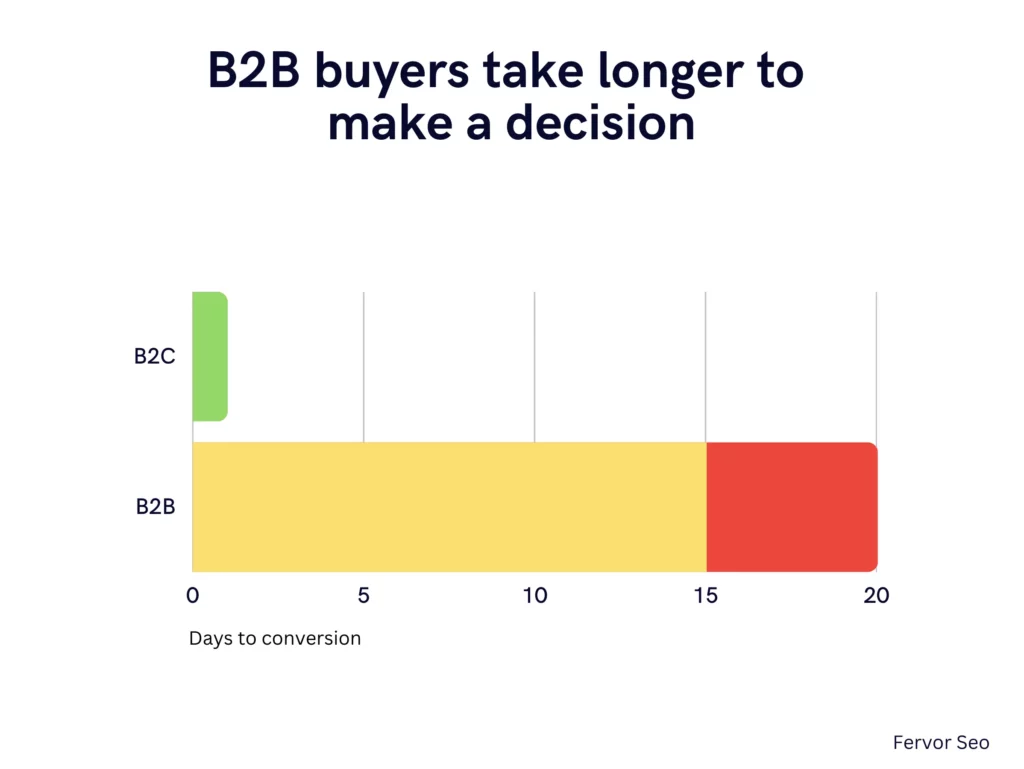
Which is justified, because they want to be sure that you are:
1. Not a scammer. They need to be sure that this company they found on the Internet is not going to run away with their money.
2. Not a charlatan. B2B buyers need to verify your expertise and make sure you know what you’re talking about. Now this will usually take a while longer than with B2C because, unlike B2C, most B2B companies aren’t household names.
If you’re buying from Dyson or SONY, you know you can trust that the product you’re buying is the product, you’re buying.
With B2B, since it’s all service-based, it takes more time to verify whether the service you’re paying for is actually backed by expertise.
So, in a nutshell, the difference between B2B and B2C funnels, can be summed up in one word:
Time.

Everything else is the same.
Stages of a B2B marketing funnel
I am sick and tired of seeing so many marketers convoluting the stages of a B2B marketing funnel. It’s like they’re unnecessarily confusing people like you trying to learn what a B2B marketing funnel is.
There’s all these wacky stages they keep coming up with:
“Consciousness”
“Perception”
“Recognition”
And I don’t even know what else.
Here are the stages: top, middle, and bottom.
Now you can name these anything you want; “attention avalanche”, “perception palooza”, “recognition registration”, etc.
That’s the kind of nonsense most marketers spin. They’ll add up all these business-sounding terms and create a marketing funnel of their own and then pretend that’s the true definition of a marketing funnel.
There’s no one-size fits all marketing funnel. The stages will differ based on your marketing strategy, deal size, buyer, service, etc.

For the purpose of this guide, we’re going to focus on content marketing as the strategy of choice.
Not only because it’s the best marketing strategy for B2B firms but also because it will make it easier for you to understand how to build a successful funnel if we just focus on one strategy.
Spreading yourself too thin over too many marketing strategies is a surefire to never gain traction in the market.
So, with that in mind, I’m going to explain the purpose of each stage in the context of client acquisition using web content as the marketing strategy.
What each stage includes
To understand how each stage of the funnel plays a role in your content marketing strategy, you first need to know what a content marketing strategy for b2b firms entails.
The steps to creating a successful content strategy are:
1. Understanding your audience
2. Keyword research
3. Creating content
4. Promoting content.
The first 2 steps are ToFu (Top Of The Funnel), and the bottom 2 are MoFu (Middle Of The Funnel).

Now, some people will argue that steps 1 & 2 aren’t really part of the funnel because your clients haven’t interacted with your company yet.
But is researching your audience not a part of marketing? Are you not building a “marketing” funnel?
Those are integral steps to successful content marketing and very much a part of the funnel. It’s just like I said, people have their own convoluted stages of a funnel they believe are the official stages of any funnel.
People have this hair-brained idea that there’s ToFu, MoFu, and BoFu, content.
Absolutely not.
You do not have content for every stage of the funnel. Content is in the middle of the funnel, every single time.

People who believe content is at the top of the funnel have failed to research their audience and are posting irrelevant crap that still requires a lot of “warming the leads” to convert them.
If your content is truly resonating with your audience, regardless of price, you don’t have to spend too much time convincing them of anything.
The leads are already warm, and they convert fast.
Now, content marketing doesn’t have too many touchpoints, so the top and middle of the funnel are easy to understand.
But since I don’t have any control over the bottom stage of your funnel- that is just you speaking to your prospective clients and closing them, I’m going to focus on the top and middle stage of your funnel and show you to build and improve them.
The funny thing is with enough quality leads at the top and middle, the bottom works itself out.
What’s the ROI you stand to make with this marketing funnel
I think it’s quite clear that the whole point of creating a marketing funnel is to create predictable revenue.
But let’s just take a little look-see here and see how much money can you really make with a content marketing funnel.
I’ll use an example for this.
Let’s say you’re a B2B accounting firm, and your clients usually spend an average of $5k with you. Now let’s say you follow all 4 steps to the tee and create 20 blog posts. Out of those, 8 posts rank well on Google and collectively bring you 3.5k people in traffic a month.
Now, assuming your content is relevant, we’ll expect a 1% conversion rate, which means 35 calls.
Out of the 35 calls, if you’re able to convert even 25% that’s about 9 clients or $45k. That’s upwards of $500k a year. And you paid what? $20k for your content?
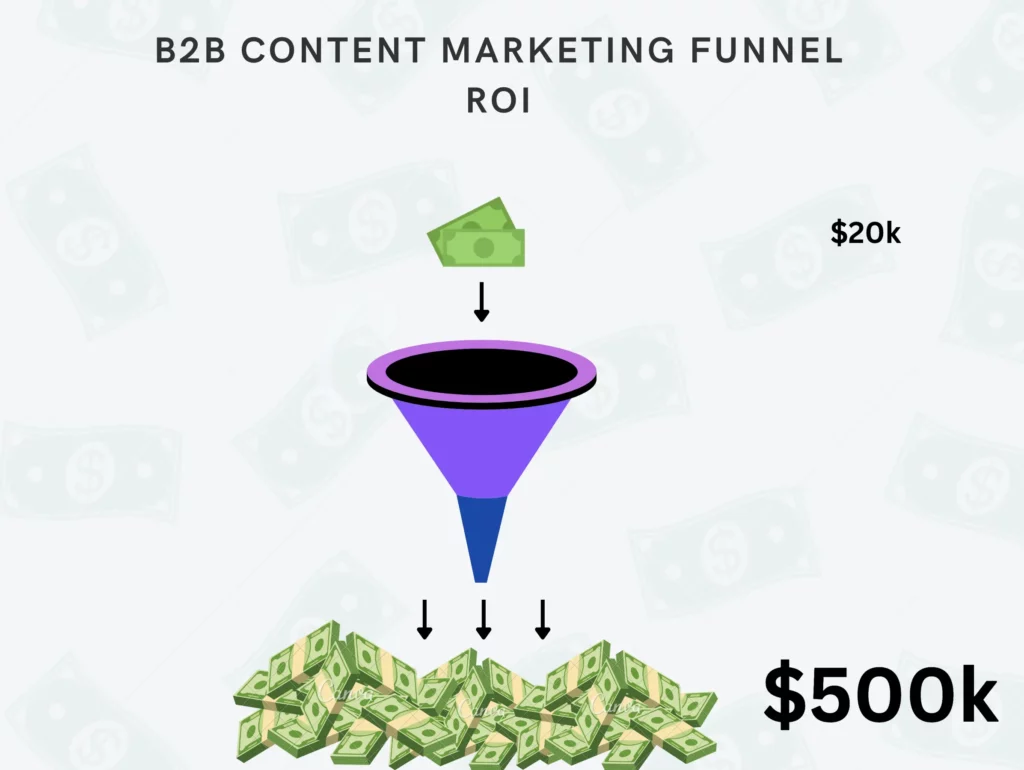
That is a 25x ROI.
And you can repeat and scale this funnel at least 5-6 times more. At which point, your business will probably be making more money than you ever thought it would.
That’s how the content marketing funnel works.
Now I’m going to show you how to build it.
ToFu
In a B2B content marketing strategy, the TOFU stage is comprised of 2 things:
1. Understanding your audience
2. Keyword research.
The purpose of this is two-fold.
It gives you a comprehensive understanding of your audience and their “pain points”, and it also informs your content topics.

Content topics is where most B2B companies struggle. As a result, they end up creating the most god awful content. It’s always some version of an advertisement veiled as “providing value”.
Literally, everyone and their brother can see through that.
Now, if you were actually advertising, this wouldn’t be a problem, but you’re trying to grow your organic presence through content marketing.
Content marketing is all about solving your client’s problems.
The reason most companies’ marketing efforts fail is because they don’t know what their audience’s problems are in the first place.
They just keep trying to sell themselves and come up with nonsense like:
“Unlocking success: how to boost sales with our product”
“The ultimate guide to boosting sales with advanced product solutions”
The ToFu stage of content marketing exists to prevent just that.
If you do this right, you can mess up the MoFu stage and still be all right. You’ll beat 50% of your competition just by choosing the right topics
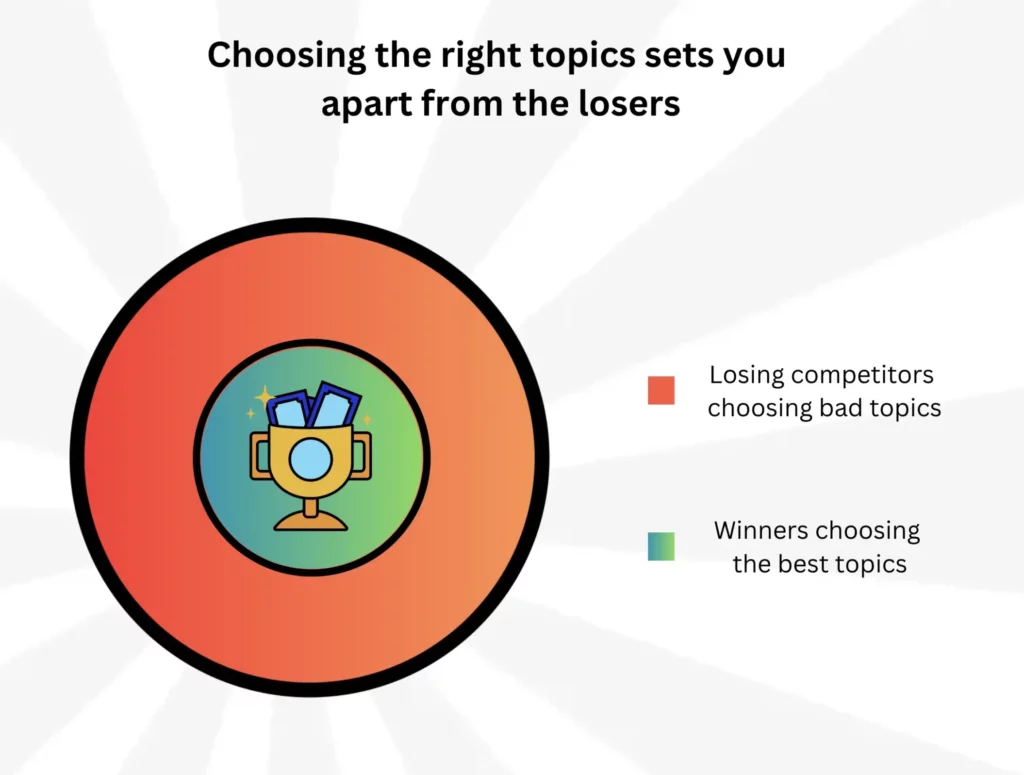
Also, if my words sound angry, they’re not. I just have a very low tolerance for the average cheesy content most companies are putting out.
That is the type of content that underperforms and erodes the business owner’s belief in marketing as a whole.
That’s the type of content that leads businesses to ruin.
Make sure that is not you.
Now let’s discuss the first part of ToFu.
ToFu stage 1: Understanding your audience
This is mission-critical, as I’ve highlighted above.
Understanding your prospects gives you the knowledge you need to create resonating content that makes them think you “get” them. Getting them generates trust in your expertise and your company because why wouldn’t it?
If you “get” them, you think like them. And if you think like them, how could you be wrong?
Now in order to get your prospects, you need to observe their behavior, personality, who they are, etc.
You’re going to create a sort of imaginative persona of who this person is, and every piece of content you write is going to be geared toward them.
Now there’s a few ways to go about analyzing your target client.
You can take the data approach, which involves referring to your website’s visitors, looking at industry statistics, etc.
But beyond the average age, gender, and marital status, you’re not going to find much.
To really understand your audience, you can’t take a magnifying glass to their data and expect to just “get” them.
That is completely the wrong approach.
I believe in taking the qualitative approach, where you examine fewer prospects, but you examine them deeply.

We’re humans, not machines. We don’t interpret through data and our conscious mind as much as we do through instinct and our subconscious mind.
There’s a simple reason for this. Your conscious mind can only handle 3-4 variables and actively think through them at a time.
Instinct, through previous life experience, can take into account a lot more variables at a time and give you a far more accurate result.
But I don’t want to turn this into an applied psychology lesson, so let’s move on to how you can research your prospects.
How to find out who your prospects are
I’m going to use an example to illustrate this. That’s the best and the only way to do it.
So let’s go ahead and say you’re an operations consulting firm. Your target prospects are COOs/ VP of operations/ heads of operations, who will champion your case to the CEO as a firm that can deliver results.
They hold the budget and 90% of the decision-making ability regarding your service.
So, your first step is to understand them.
Now up to this point, most people will be in agreement with me. But right around here is where they mess up.
Instead of researching the COO’s pain points, they research the business’s pain points.
The business is not a person. It doesn’t make a decision, the COO does.
You need to know what his endgame is and how your company adds value to that.
So, for example, a company’s pain point would be aligning operations to match marketing goals.
But the COO’s pain point is something like this “If I hire this company to align our operations with our marketing goals, will they screw us over?”.
Then, he’s going to think, “Well if they do, I’m getting the sack for sure. Yeah, better not risk it. Let’s just play it safe. At least my neck won’t be on the line.”
So, you can see, the company’s goal is to align operations and marketing, but the COO wants to deliver results while minimizing his risk.
And the way you can action this in your blog post would be, instead of focusing on the stellar results you can deliver, you focus on the risk you can minimize.
I promise you 90% of your competitors do not think this way.
Simply researching your prospect this way will be a huge differentiator between you and your competitors.
It keeps your prospect from dismissing you as “just another of those guys trying to sell me something”.

The prospect research process
The actual process to research your prospect couldn’t be simpler.
Start by collecting some basic data on them like age, gender, marital status, etc.
A simple Google search like COO statistics in the U.S. will reveal that to you.
Once you have that information, head over to Reddit.
You’re going to scour Reddit to find COOs using Reddit and then do a deep dive into 5-6 profiles and investigate the type of people they are.
All you need to do is find a subreddit where your prospects hang out. In the off chance, you cannot find a subreddit for your prospect, just type in the prospect’s title in the search bar with something relevant and see what comes up.
So, for example, here I’d type in “I’m a COO” or “been a COO” or something like that, and that will yield at least 5-6 people I can look up.
Once you’ve found the profiles, go through their posts and comments to see what communities they hang out in. That will reveal a lot to you. Additionally, you read through their comments and observe their stances on other people’s posts.
You can research them however, but the main idea here is to get an understanding of the type of values they have more than whether they like cats or dogs.
Go through 5-6 prospect profiles and look for commonalities to help you determine their collective values. Once you’ve ascertained their value structure, I want you to comprehensively (at least 300 words) note down everything you can about them.
Create an imaginative person who has the average value structure of the 5-6 profiles, you looked into, and create a persona.

That persona is who are you going to be creating content for.
Now, of course, it goes without saying that you will need to exercise a lot of manual judgment here, and use your intuition to guide you.
But once you have this persona ready, you can rest assured your content relevance will be through the roof, and your funnel will start filling up.
ToFu Stage 2: Keyword research
Now that you have your audience ready, I’m going to show you how to do keyword research.
Or, in other words, I’m going to show you how to find topics to write about.
So, the reason you want to do keyword research instead of just creating content right away is that, although you understand your audience, you don’t know which questions are most important to them.
Or maybe you do…
But you certainly don’t know which questions are the most important to them and least covered by your competitors.
Give it a try.
Think you have a topic?
Type that into Google and see the powerhouse competitors that show up in the results.
You need keyword research because it will help you with high-traffic low-competition keyword clusters.
All that is, is a bunch of relevant keywords that are popular, but don’t have anyone covering them right now.
Basically, gaps in supply and demand.
You’re going to fill in those gaps, and as a result, the top of your funnel will start filling up.
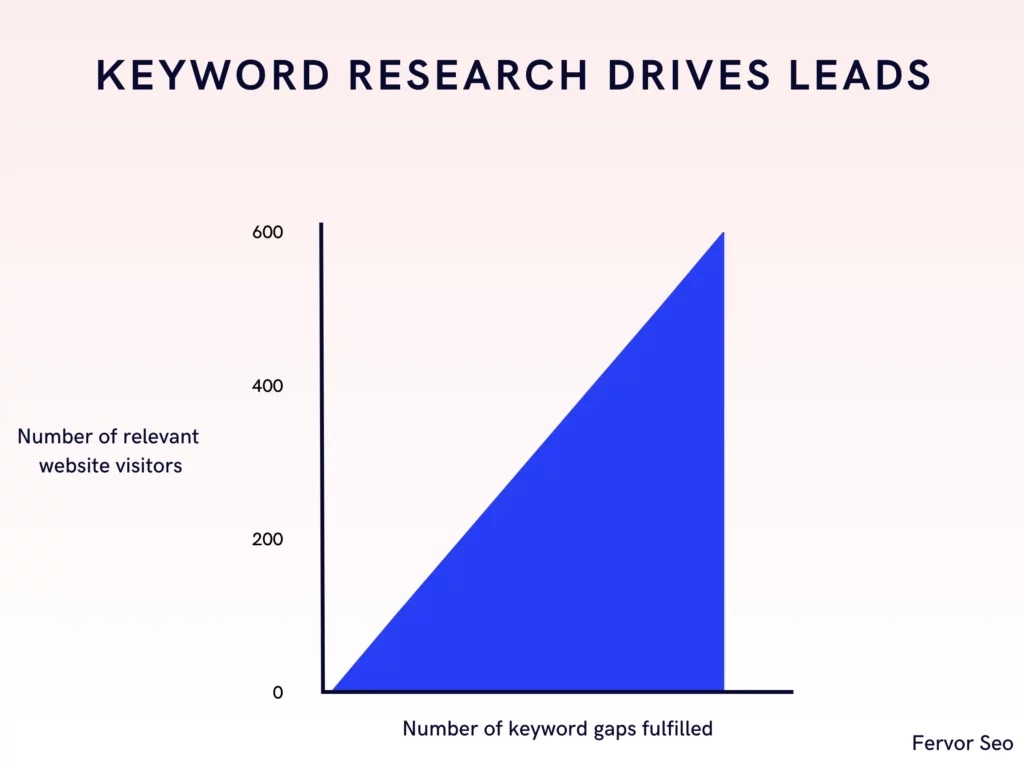
Keywords are nothing but queries people type into Google to research something.
When you have a problem and need a solution, you type a query into Google.
Your prospects are typing in queries into Google every minute, and we’re going to use keyword research to find out what those queries are.
The keyword research process
Keyword research is a very analytical process. I’ll lay out a simple version for you here:
Step 1: Find your competitors.
Research Google a bit to find out who your powerhouse competitors on Google are. “Best operations consulting firm” or whatever your B2B service is should reveal that to you. Either through directories like clutch or through the Google search results itself. List 5 competitors.

Step 2: Use an SEO suite to get their keywords
Use SEMrush/Ahrefs/Ubersuggest etc. to find your 5 competitors’ keywords. Go to any of these tools, and type your competitors’ domains in the search box one by one. This will reveal all their keywords to you.
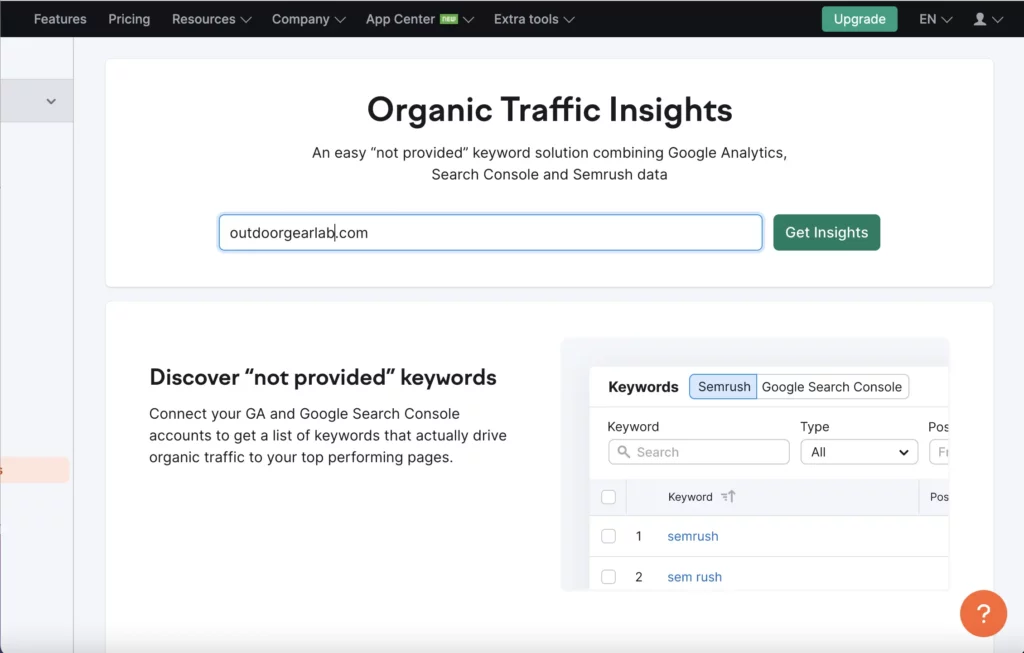
Export all those keywords to an Excel sheet. You should end up with about 20k keywords.
If you have less than 20k keywords, you’ve chosen the wrong competitors. The competitors you’ve chosen are not powerhouses on Google, or they’d have a larger keyword footprint.
Usually, the competitors with the least amount of keywords are the ones that need to be replaced.
Step 3. Find industry keywords
Critically think about your business and the companies that you work with and come up with commonly used, relevant industry terms.
For example, if you’re in marketing this could be:
“content marketing”
“b2b marketing”
“marketing strategy”
“marketing guide”
Etc.
Come up with 20 – 30 terms like this. Then one by one, enter each of those terms in the find function (Ctrl + F) in Excel and find all the keywords that contain your industry terms.

Copy those keywords and paste them into a separate sheet. Remember to copy all their metrics as well.
You’ll need to do this individually for every industry term you’ve come up with. I know. It’s time-consuming. Unfortunately, there’s no faster way to do it.
Step 4. Find your topics
Once you’ve copied your industry keywords in a separate sheet, sort them by search volume.
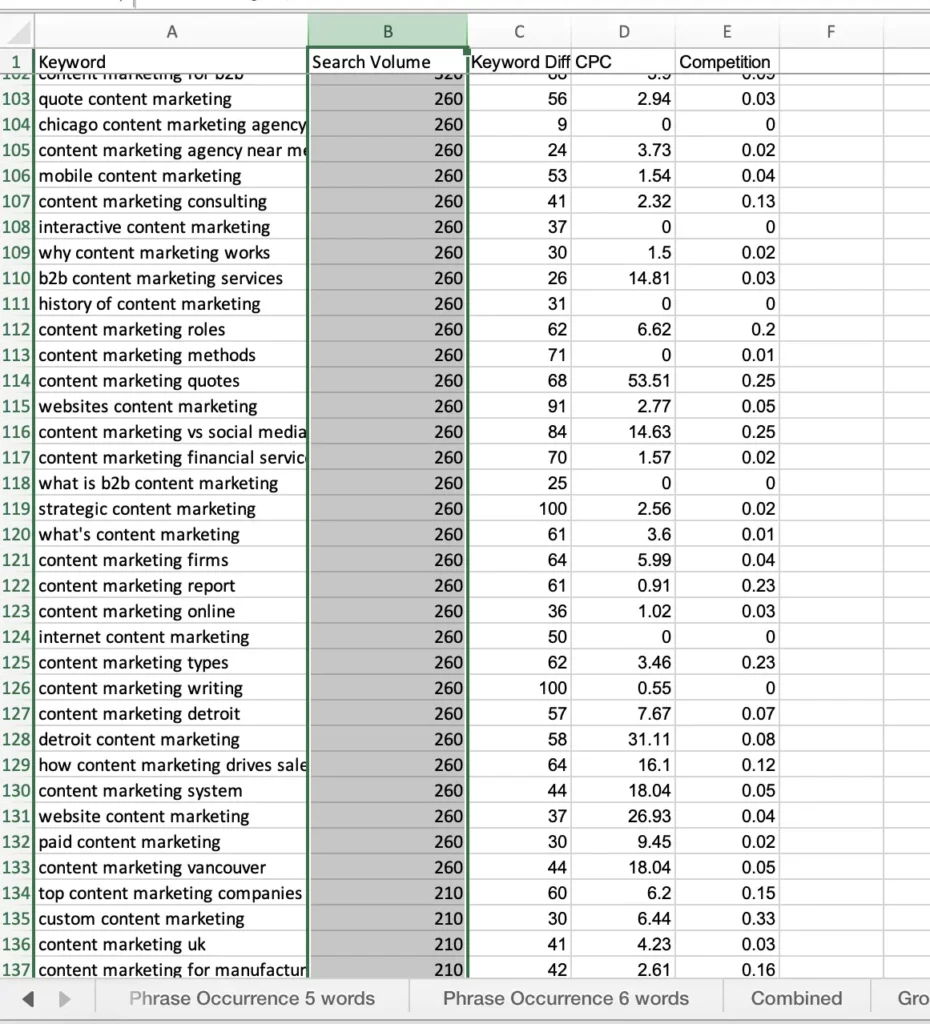
All the high-volume keywords are going to be too difficult for you to rank for in the beginning, so forget about those.
Focus on lower-volume topics with low keyword difficulty.
Those are the keywords you’re going to create content around in the beginning.
Once your site has some authority and backlinks, as a result of your initial content, you can focus on high-volume keywords.
Additionally, before you start writing about a topic, search it on Google once to see the results that come up.
If the results are other companies like yours addressing the topic, go ahead. But if it’s aggregators or larger topics containing the topic you want to talk about coming up in the search results, choose another topic. This will happen roughly 1 out of 4 times.
MoFu
Once you’ve chosen the right topics to talk about, 50% of your work is done.
In the MoFu stage of the funnel, you want to put those topics to good use and interact with your clients through your content.
This is where you’ll find your prospective clients calling in about your blog posts and whether you can help them with their problem.
Your objective in the MoFu stage is to inspire trust in your company. You don’t want your prospective clients thinking you’re some kind of scam artist.
The best way to inspire trust in your firm is to create content that resonates with their thought process. And since you already have a deep and genuine understanding of how your prospect thinks, this should be a breeze.
If your content is truly resonating with your prospects, you can generate a lot of “warm leads” here.
These are leads that should be ready to sign within 1-2 calls.
Done right, this stage of the funnel can reduce the number of salespeople you need, and the length of your sales cycle.
It comprises:
1. Content Creation
2. Content Promotion.
Let’s dive in.
MoFu stage 1: Content Creation
Most people have the wrong mindset about content creation. The first thing you need to do is make sure you have the correct perspective.
This is the bridge between you and your prospects.

It’s the quality of your content that will determine whether your blog posts rank for relevant keywords and convert your prospects to paying clients.
Content is not something that you just write and throw on your blog.
That’s the type of mentality that most of your competitors have, and that’s why their marketing efforts are failing.
The whole reason you want to create content is so that you can convert your prospects into actual paying customers. When you create content with this thought process, it will influence how you write. Thereby, making sure that every sentence in your article speaks to the heart of your prospect, which I know this sounds corny, but it’s true.
Emotionally activating content is what drives leads. When your prospect reads your content, they should think this whole post was made exclusively for them.

Now, I’m going to give you some simple marketing fundamentals you can follow to create resonating content.
1. Speak directly, don’t sound weak.
Be firm and confident in the way you write your content. People like to do business with people who know what they’re doing. If you’re writing with a lot of “buts”, “maybe”, “might”, etc., all you’re doing is setting yourself up for a lower conversion rate.
Imagine if you had two companies contact you and one said, “Do this and you’ll get results.”
And the other said, “Maybe, if you try this, it can work, I think.”
Who are you trusting with your business?
There’s this notion going around about “setting expectations”. That’s fine, but be clear. Do not be unclear about setting expectations.
“If you do this, you’ll get this.”
Simple.
Beating around the bush will not only make your voice sound under-confident, but you’ll also sound un-engaging.

It is VERY boring to read a piece of text that is not direct.
Who wants to read “yeahs” and “buts” and “maybe if this” and “maybe if that”?
This is the kind of garbage B2B firms are putting out though. I’m not even joking. Go on to your competitors’ websites and see what they’re writing.
To inspire trust in your competence and expertise, be DIRECT.
2. Don’t say in 100 words what you can say in 10.
This is real simple, don’t ramble.
Like I mentioned before, create content to solve your client’s problem, not to fill in words.
Fluffy content that seems generic and doesn’t resonate with your prospect is the quickest way to not rank and convert.
3. Have a unique voice, not a “B2B writing voice”
However, you speak is how you should write. For the love of God, do not start writing in a “B2B style”.
You are speaking to a human, not a business.
Humans want to read interesting things. They don’t want to be bogged down with sentences like:
“Through modern synergies and global innovation, we were able to accomplish all our fiscal targets for 2023.”
Who wants to read that crap?
Don’t needlessly flower up your words.
Just talk to them, like they walked into your office and decided to have a conversation with you.
4. Write skyscraper posts to obliterate your competitors
A skyscraper post is a post that towers above your competitors. Meaning, it is head and shoulders above your competitors’ posts in quality and comprehensiveness.
The better content quality and increased content coverage makes it more likely that you’ll rank on Google.
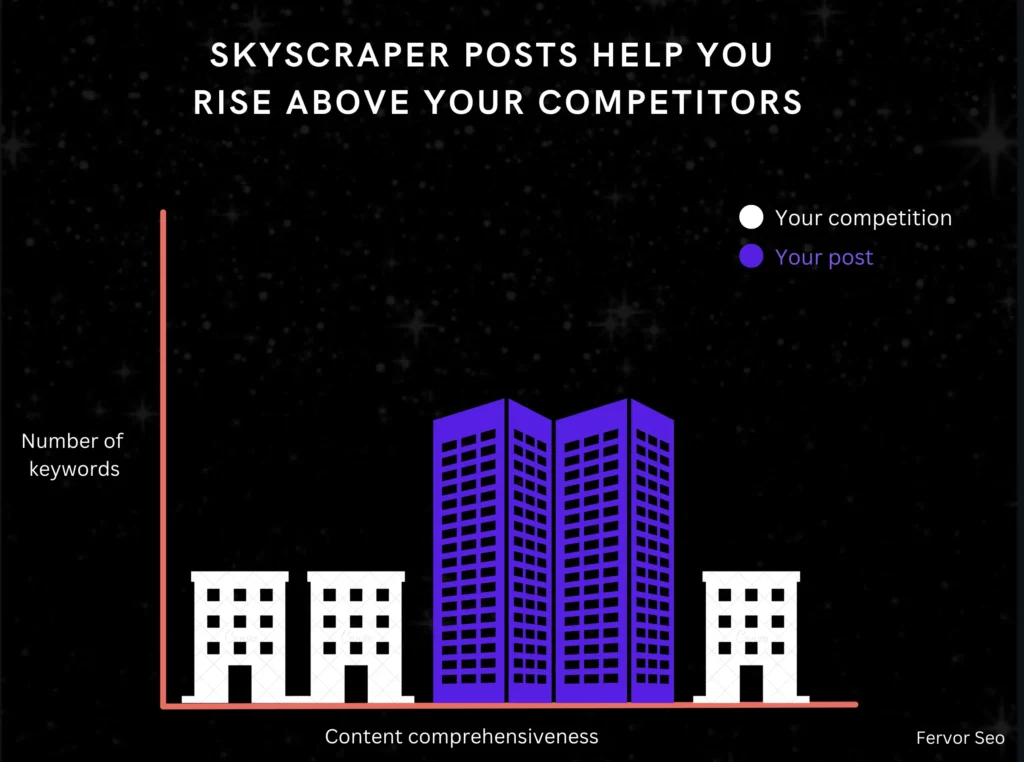
To create a skyscraper post, you need to know how to beat your competitors’ posts.
Which you can find out through a SERP analysis.
A SERP analysis is a Search Engine Results Page analysis. It’s basically like a competitor analysis for a specific topic.
A SERP analysis informs:
- Your post type (listicle, how-to guide, case study, etc.)
- What to focus on in your post
- Post word count
- Post Title
- Post content structure
And more than anything it makes your post the most qualitative and comprehensive resource on the topic you’re writing about. Well, at least on the internet.
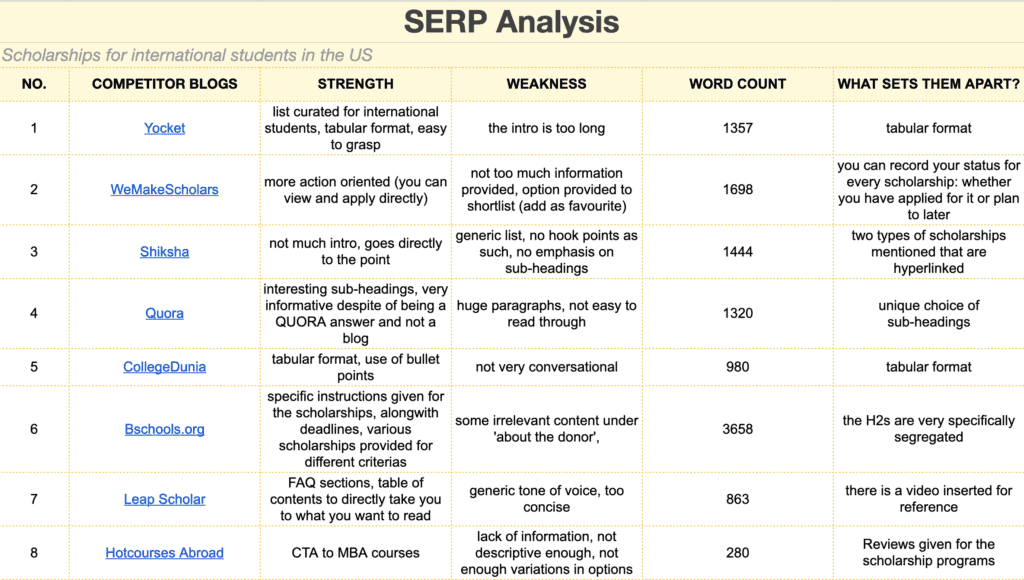
To run a SERP analysis:
1. Type your keyword into Google. So let’s say your keyword is “Lean Manufacturing Techniques“ you’re going to type in “Lean Manufacturing Techniques“ into Google and review the results that come up.
2. You’re going to review the first 5 posts/articles. Exclude Wikipedia, directories, or something else unrelated.
3. Then, you’re going to go through each of the posts and list their strengths, weaknesses, and word counts.
4. Review their weaknesses and find commonalities. It could be something like unengaging tonality, bad content sequencing, bad design, irrelevant content, etc. You’re going to leverage their weakness as your strength by doing well whatever they’re doing wrong. So, if the weakness, you’ve found is unengaging tonality, you’re going to go the extra mile to be more engaging with your post.
5. Take the average of the 5 posts’ word counts, and double it. That will make your post more comprehensive as well.
6. Create a content outline keeping the word count and differentiator (engaging tonality) in mind.
MoFu stage 2: Content Promotion
Now, instead of taking a spray-and-pray approach with your content, you can actively work to get eyeballs to your post.
Content, on average, takes 6 months to rank on Google, but if you can leverage a newsletter to funnel people to your post, the positive user behavior will signal to Google that it should rank your post.
It accelerates the ranking process.
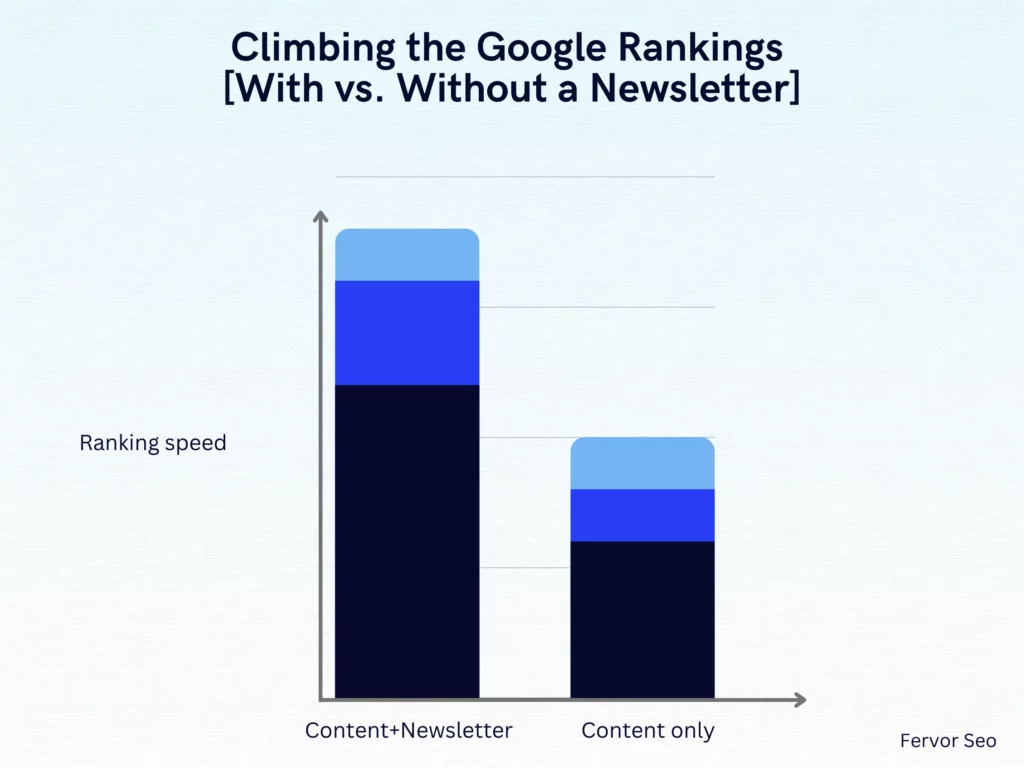
Use a newsletter to spread the word.
This is not a very complicated stage of the funnel. Creating a newsletter is quite simple.
1. Collect a bunch of prospect emails. You can use lead magnets, pop-up forms, social media, etc., to do this. Once your content is ranking, you’ll have people signing up through pop-up newsletter forms.
2. “Provide value” to your prospects. Don’t sell. Create a 100-word excerpt on every new piece of content you post on your blog. In this excerpt preview the problem, the solution, and the outcome of the solution. Funnel people to your blog post this way.
3. You can use Mailchimp or email automation software to get this done 100x faster.
Optimizing your funnel conversion rate
Well, congratulations! You’ve built your marketing funnel.
Now, it’s going to work hunky-dory right off the bat. So here’s how you address all the common issues that’ll inevitably come up while you’re running your funnel.
1. “My content is not ranking. This doesn’t work. I knew I shouldn’t have listened to that guy on the internet”
Take a breath. Most people have a hard time ranking their content.
It’s competitive.
Here’s what’s happening. You are either not choosing the right topics or you’re not doing a SERP analysis.
Choose low-competition topics to start.
Alternatively, there could be something off with your website’s technical SEO. Which you can get checked by any SEO expert. Us included.
2. “My content is not converting.”
This is very rare. 90% of the time if your content is good enough to rank, it’s good enough to convert.
If it’s not converting refer back to MoFu stage 1. Apply the marketing fundamentals I’ve laid out, and you should see conversions.
Also, keep in mind, the conversion rate is generally between 0.5% to 1.5%. If you’re within that range, you’re fine.
And by conversion rate, I’m talking about the number of people who contact you, not the number of people that become paying customers. That’s BoFu and out of the scope of your content marketing funnel.
3. “I’m getting trash leads”
If most of the leads you’re receiving are not converting actual paying clients, reconsider the topics you’re targeting.
Ensure the topics you’re targeting are actually topics your prospect would search for.
A lot of times, when you’re putting out informational content, you’ll get people with all kinds of budgets trying to learn the craft.
If you’re inundated with leads that aren’t converting and that’s wasting your sales team’s time, change up the booking form.
Add some more details on your booking page, like company size, revenue, etc.
Then, just don’t call the prospects who don’t meet the size/revenue requirements.
I’d also add a small section for your prospects to describe what they need help with. This will separate the casual prospects from the serious ones willing to describe their problem in detail.
How long will it take to build this funnel and see results?
So, I showed you how you can make upwards of $500k by creating and running this funnel just once.
But it’s not fast, and it’s not easy.
So, I’m not going to sugarcoat anything for you.
ToFu stages 1 and 2 will take you about 1 month. MoFu will take you about 3 months.
And this is if you’re working on the funnel full-time. 8 hours a day.
Then, it’ll take your content 6 months to rank.
So, the total time for you to start seeing results is 10 months. 4 months to build the funnel. 6 months to see results.
It also takes a level of skill to get the funnel right the first time. If you don’t have the skill, it will take longer than 10 months.

The truth is, all but the most successful of your competitors thought they could do content themselves and failed.
This is why you’ll so often hear “content is dead”, “Google is dead”, “Blog posts are dead”.
It is merely the cries of the inept who lost to the adept.
That’s why such a small share of powerhouses control the market share on Google. And if you want to be one of those powerhouses, the best way to build and run this funnel is to outsource it.
We can do this faster and better than anyone since we came up with it and have done it many times over.
If you want to have us create this funnel for you or discuss your website’s content, use the button below to reach out.
We’ll be happy to talk, and put your marketing on the right track.
